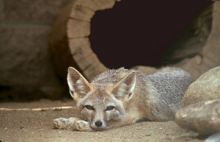Article
Foxes are canines that tend to be on the small size, with large upright ears and a large, bushy tail. They are opportunistic, ominvorous, and highly adaptable. In addition, although they can survive in a pack, they also do well on their own. As such, they have found a niche on every continent, except for Antarctica, where they have earned a variety of reputations as hunters, pests, and even beloved domesticated companions.
In folklore, because of their similarity to both coyotes and wolves, foxes tend to get lumped under the characteristic attributes of the other two. Seen as cunning tricksters, foxes are perceived with ambivalence, similar to coyote figures, whose nature is neither good nor bad. In the Navajo tradition, for example, foxes are viewed as a good animals that represent material goods. In addition, the fur and tails are used in different ceremonials such as Night Way and Coyote Way. Yellow and Blue Fox are mentioned a few times in the Navajo origin story. However, it appears that the larger gray fox or desert fox (Urocyon cinereoargenteus) can sometimes be associated as a Skinwalker or were-animal. Clyde Kluckhohn in Navaho Witchcraft asserts that, along with bear, owl, and crow, witches can take on the form of desert foxes.
"Endangered San Joaquin kit fox (Vulpes macrotis mutica)" by USFWS Endangered Species is licensed under CC BY.
Manuscripts
References
Arizona-Sonora Desert Museum
2015 Coyote & Fox. http://www.desertmuseum.org/books/nhsd_coyote_new.php,
accessed January 13,
2015.
azgfd.gov
1988 DINÉ TRADITIONAL TEACHINGS ON WILDLIFE Din¢k’ehgo Nahasdz¡¡n dºº
Y¡di¬hi¬ Yiyi’dºº Yik¡¡’ Hin¡anii Bee Na’nitin A Guide For Teachers.
http://www.azgfd.gov/i_e/ee/resources/books/dine_guide.pdf, accessed January 13,
2015.
Cooper, Guy H.
1987 Coyote in Navajo Religion and Cosmology. Canadian Journal of Native Studies. 7(2):
181-93.
Kluckhohn, Clyde
1962 Navaho Witchcraft. Boston: Beacon Press.
navajopeople.org
2012 Yei Bi Chei (Yébîchai) Night Chant-First Day. http://navajopeople.org/blog/yei-bi-
chei-night-chant-first-day/, accessed January 13, 2015.
Stephen, A. M.
1930 Navajo Origin Legend. The Journal of American Folklore. 43(167): 88-104.
Werner, Oswald
1983 A Taxonomic View of the Traditional Navajo Universe. Handbook of North American
Indians, Vol. 10. . A. Ortiz, ed. Pp. 585. Washington: Smithsonian Institution Washington.
Wyman, Leland C.
1983 Navajo Ceremonial System. In Handbook of North American Indians, Vol. 10. . A.
Ortiz, ed. Pp. 536-557. Washington: Smithsonian Institution Washington.

